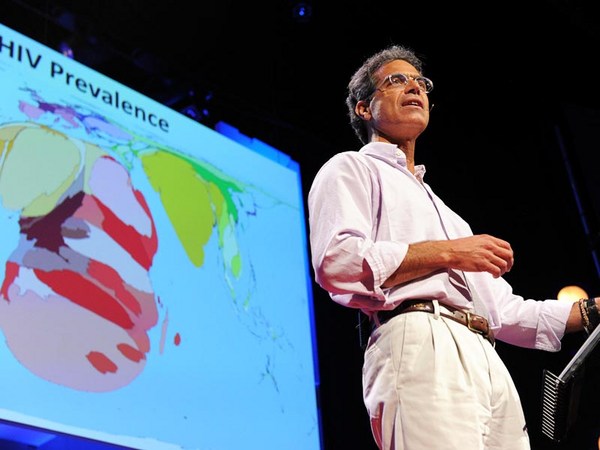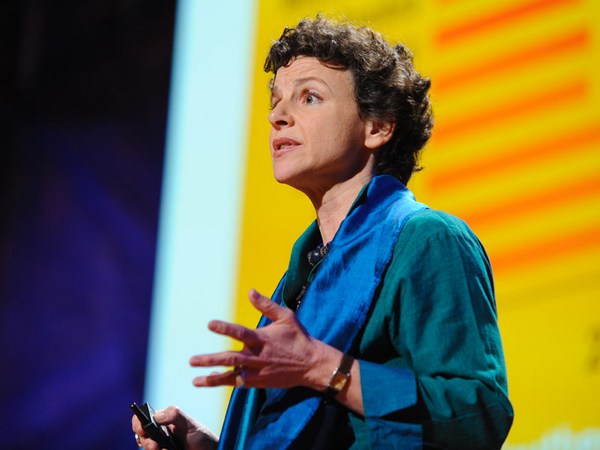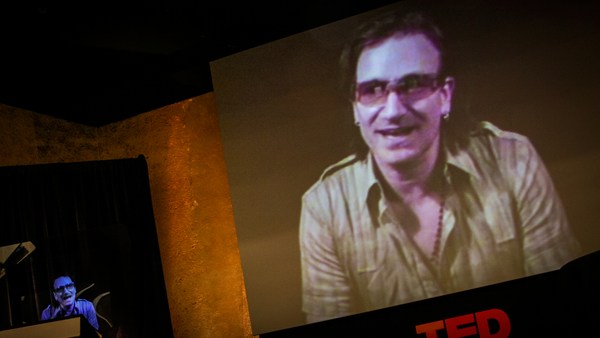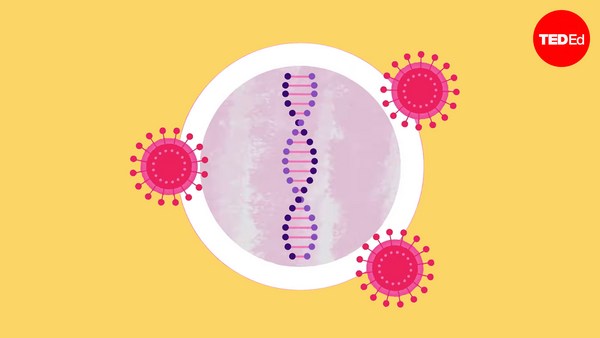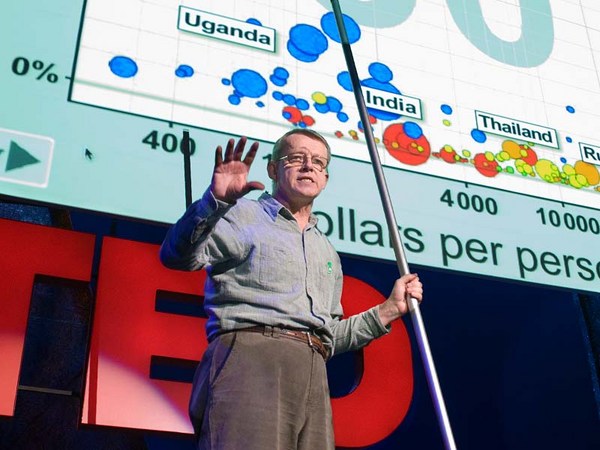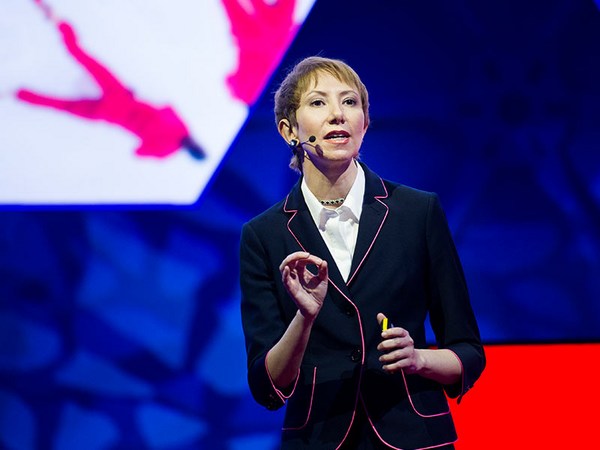I'm going to share with you the story as to how I have become an HIV/AIDS campaigner. And this is the name of my campaign: SING Campaign. In November of 2003, I was invited to take part in the launch of Nelson Mandela's 46664 Foundation -- that is his HIV/AIDS foundation. And 46664 is the number that Mandela had when he was imprisoned in Robben Island. And that's me with Youssou N'Dour, onstage, having the time of my life. The next day, all the artists were invited to join Mandela in Robben Island, where he was going to give a conference to the world's press, standing in front of his former prison cell. You can see the bars of the window there. It was quite a momentous occasion for all of us. In that moment in time, Mandela told the world's press that there was a virtual genocide taking place in his country; that post-apartheid Rainbow Nation, a thousand people were dying on a daily basis and that the front line victims, the most vulnerable of all, were women and children.
This was a huge impact on my mind, because I am a woman and I am a mother, and I hadn't realized that the HIV/AIDS pandemic was directly affecting women in such a way. And so I committed -- when I left South Africa, when I left Capetown, I told myself, "This is going to be something that I have to talk about. I have to serve." And so, subsequently I participated in every single 46664 event that I could take part in and gave news conferences, interviews, talking and using my platform as a musician, with my commitment to Mandela -- out of respect for the tremendous, unbelievable work that he had done. Everyone in the world respects Nelson Mandela, everyone reveres Nelson Mandela. But do they all know about what has been taking place in South Africa, his country, the country that had one of the highest incidents of transmission of the virus? I think that if I went out into the street now and I told people what was happening there, they would be shocked.
I was very, very fortunate a couple of years later to have met Zackie Achmat, the founder of Treatment Action Campaign, an incredible campaigner and activist. I met him at a 46664 event. He was wearing a t-shirt like the one I wear now. This is a tool -- this tells you I am in solidarity with people who have HIV, people who are living with HIV. And in a way because of the stigma, by wearing this t-shirt I say, "Yes, we can talk about this issue. It doesn't have to be in the closet." I became a member of Treatment Action Campaign and I'm very proud to be a member of that incredible organization. It's a grassroots campaign with 80 percent membership being women, most of whom are HIV-positive. They work in the field. They have tremendous outreach to the people who are living directly with the effects of the virus. They have education programs. They bring out the issues of stigma. It's quite extraordinary what they do. And yes, my SING Campaign has supported Treatment Action Campaign in the way that I have tried to raise awareness and to try to also raise funds. A lot of the funding that I have managed to raise has gone directly to Treatment Action Campaign and the incredible work that they do, and are still continuing to do in South Africa.
So this is my SING Campaign. SING Campaign is basically just me and about three or four wonderful people who help to support me. I've traveled all over the world in the last two and a half years -- I went to about 12 different countries. Here I am in Oslo in Norway, getting a nice, fat check; singing in Hong Kong, trying to get people to raise money. In Johannesburg, I had the opportunity to play to a mainly white, middle-class South African audience who ended up in tears because I use film clips that really touch the heart, the whole nature, of this terrible tragedy that is taking place, that people are tending to avoid, because they are fatigued, and they really don't quite know what the solutions are. Aaron Motsoaledi, the current health minister, attended that concert and I had an opportunity to meet with him, and he gave his absolute commitment to try to making a change, which is absolutely necessary. This is in the Scottish Parliament. I've subsequently become an envoy for Scotland and HIV. And I was showing them my experiences and trying to, again, raise awareness. And once again, in Edinburgh with the wonderful African Children's Choir who I simply adore. And it's children like this, many of whom have been orphaned because of their family being affected by the AIDS virus.
I'm sitting here in New York with Michel Sidibe -- he's the director of UNAIDS. And I'm very honored by the fact that Michel invited me, only a few months ago, to become a UNAIDS ambassador. And in this way, I've been strengthening my platform and broadening my outreach. The message that UNAIDS are currently sending out to the world is that we would like to see the virtual elimination of the transmission of the virus from mother to child by 2015. It's a very ambitious goal but we believe it can be achieved with political will. This can happen.
And here I am with a pregnant woman, who is HIV positive and we're smiling, both of us are smiling, because we're very confident, because we know that that young woman is receiving treatment so her life can be extended to take care of the baby she's about to give birth to. And her baby will receive PMTCT, which will mean that that baby can be born free of the virus. Now that is prevention at the very beginning of life. It's one way to start looking at intervention with the AIDS pandemic.
Now, I just would like to finish off to tell you the little story about Avelile. This is Avelile -- she goes with me wherever I go. I tell her story to everyone because she represents one of millions of HIV/AIDS orphans. Avelile's mother had HIV virus -- she died from AIDS-related illness. Avelile had the virus, she was born with the virus. And here she is at seven years old, weighing no more than a one year-old baby. At this point in her life, she's suffering with full-blown AIDS and had pneumonia. We met her in a hospital in the Eastern Cape and spent a whole afternoon with her -- an adorable child. The doctors and nurses were phenomenal. They put her on very special nutritious diet and took great care of her. And we didn't know when we left the hospital -- because we filmed her story -- we didn't know if she was going to survive. So, it was obviously -- it was a very emotional encounter and left us feeling very resonant with this direct experience, this one child, you know, that story. Five months later, we went back to South Africa to meet Avelile again. And I'm getting -- the hairs on my -- I don't know if you can see the hairs on my arms. They're standing up because I know what I'm going to show you. This is the transformation that took place. Isn't it extraordinary?
(Applause)
That round of applause is actually for the doctors and nurses of the hospital who took care of Avelile. And I take it that you appreciate that kind of transformation. So, I would like to say to you, each one in the audience, if you feel that every mother and every child in the world has the right to have access to good nutrition and good medical care, and you believe that the Millennium Development Goals, specifically five and six, should be absolutely committed to by all governments around the world -- especially in sub-Saharan Africa -- could you please stand up. I think that's fair to say, it's almost everyone in the hall.
Thank you very much.
(Applause)
